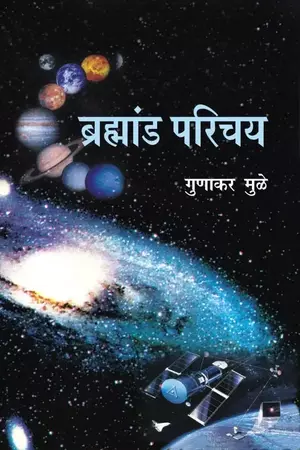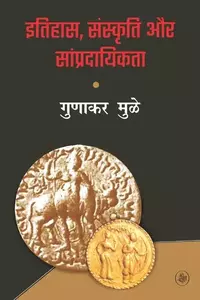|
पर्यावरण एवं विज्ञान >> ब्रह्मांड परिचय ब्रह्मांड परिचयगुणाकर मुले
|
426 पाठक हैं |
|||||||
"ब्रह्मांड की खोज : वैज्ञानिक दृष्टि से अंतरिक्ष और खगोल का परिचय"
प्रस्तुत हैं पुस्तक के कुछ अंश
इन सवालों के उत्तर प्राप्त करने के लिए सहस्राब्दियों तक आकाश के ग्रह-नक्षत्रों की गति-स्थिति का अध्ययन किया जाता रहा। विश्व के नए-नए मॉडल प्रस्तुत किये गए। परंतु विश्व की संरचना और इसके विविध पिंडो के भौतिक गुणधर्मों के बारे में कुछ सही जानकारी हमें पिछले करीब दो सौ वर्षों से मिलने लगी है। इसमें भी सबसे ज्यादा जानकारी पिछली सदी के आरम्भ से और फिर अंतरिक्षयात्रा का युग शुरू होने के बाद मिलने लगी है। खगोल-विज्ञान हालाँकि सबसे पुराना विज्ञान है, परन्तु ब्रह्माण्ड की संरचना और इसके विस्तार के बारे में सही सूचनाएँ पिछले करीब तीन सौ वर्षों में प्राप्त हुई हैं। इस समूची जानकारी का ग्रन्थ में समावेश है।
अगस्त 2006 में अन्तर्राष्ट्रीय खगोल-विज्ञान संघ ने ‘ग्रह’ की एक नई परिभाषा प्रस्तुत की। इसके तहत सौरमंडल के ‘प्रधान’ ग्रहों’ की संख्या 8 में सीमित हो गई और प्लूटो, एरीस तथा क्षुद्रग्रह सीरेस अब बौने ग्रह बन गए हैं। इस नई व्यवस्था का ग्रंथ में समावेश है, विवेचन है।
प्राक्कथन
आदिम मानव के लिए भी काल-ज्ञान व दिशा-ज्ञान भौतिक आवश्यकताएं थीं, और यह ज्ञान आकाश के पिंडों की गतियों का सतत अवलोकन करने से ही प्राप्त हो सकता था। सहस्राब्दियों के संचित अनुभव से प्राचीन मानव ने जान लिया था कि शिकार, फल-मूल या अनाज-जैसी उसकी भोजन सामग्री का संबंध ऋतुओं से है और ऋतुचक्र का ज्ञान सूर्य तथा नक्षत्रों की गतियों का अवलोकन करने से होता है।
प्राचीन मानव ने सोचा : अवश्य ही उसकी भोजन- सामग्री–वन्य पशु व वनस्पति–आकाशस्थ पिंडों की गति स्थिति से ‘प्रभावित’ है। उसने आकाश के इस ‘प्रभाव’ को अपने ऊपर भी ओढ़ लिया। इस तरह, फलित-ज्योतिष का व्यवसाय अस्तित्व में आया।
ताम्रयुगीन सभ्यताओं में पुरोहित की ज्योतिषी थे और मंदिर वेधशालाएं। ये पुरोहित-ज्योतिषी अज्ञेय प्राकृतिक घटनाओं के प्रतीक देवी-देवताओं को प्रतिनिधित्व करते थे और राजा एवं प्रजा को समय की सूचनाएं भी देते थे, इसलिए तत्कालीन समाज में इनका बड़ा सम्मान था। सूर्य और चन्द्र की गतियों का निरंतर अध्ययन करते रहने से आगे चलकर जब ये
पुरोहित-ज्योतिषी ग्रहणों के बारे में भी भविष्यवाणी करने में समर्थ हुए, तो इनका सम्मान व सामर्थ्य और भी अधिक बढ़ा। लोगों ने सोचा–ये पुरोहित-ज्योतिषी कालज्ञान तथा शुभ मुहूर्तों के प्रवक्ता हैं, ग्रहणों-जैसी भयावह घटनाओं के भविष्यवक्ता हैं, इसलिए ये मानव-जीवन की अगामी घटनाओं के बारे में भी भविष्यवाणी कर सकते हैं।
इस प्रकार पुरोहित-ज्योतिषी के अंतर्गत ही फलित-ज्योतिषी ने जन्म लिया। वैदिक काल में अत्रि कुल के पुरोहति-ज्योतिष ग्रहणों का लेखा-जोखा रखते थे और इनके बारे में भविष्यवाणी करते थे। उधर हम्मुराबी-कालीन (ईसा-पूर्व अठारहवीं सदी) बेबीलोन के पुरोहित-ज्योतिषी, न केवल ग्रहणों के भविष्यवक्ता थे, बल्कि राजा और राज्य का भी भविष्य बताने लग गए थे। सम्मान व सम्पत्ति के लोभ वश इन पुरोहित-ज्योतिषियों ने ज्योतिष-ज्ञान को रहस्य का जामा पहनाया और इसे सदियों तक अपने ही वर्ग तक सीमित रखा।
बदलती सामाजिक, राजनीतिक और आर्थिक परिस्थितियों के अनुसार काल्पनिक देवी-देवताओं के कृत्रिम स्वरूपों में रद्दोबदल करते जाने में कोई कठिनाई नहीं थी। हुआ भी ऐसा ही है। किंतु आकाश में पिंडों की नियमित गतियों में परिवर्तन करना आदमी के बस की बात नहीं था। मुख्यतः इसी भेद के कारण, बाद में, भारत के संदर्भ में ईसा की पहली सदी के आसपास से, पुरोहित-ज्योतिष का पेशा दो वर्गों में बंट गया–पुरोहित और ज्योतिषी। लेकिन अभी गणित-ज्योतिषी ही फलित-ज्योतिषी भी था। यह भी देखने को मिलता है कि कुछ गणितज्ञों का झुकाव गणित-ज्योतिष की ओर अधिक होता था और कुछ का फलित-ज्योतिष की ओर। आर्यभट (जन्म 476 ई.) को हम एक महान गणितज्ञ ज्योतिषी मानते हैं, तो वराहमिहिर (ईसा की छठी सदी) के ग्रंथ आज भी फलित-ज्योतिषियों के लिए शुभ-अशुभ विद्या के अक्षय भण्डार हैं।
खगोल-विज्ञान या ज्योतिर्विज्ञान के विकासक्रम (देखिए परिशिष्ट 1) का अध्ययन करने से स्पष्ट होता है कि जब तक आकाश के पिंडों का अवलोकन उनकी प्रत्यक्ष गतियों एवं स्थितियों तक सीमित रहा, तभी तक गणित-ज्योतिष जैसे-तैसे फलित-ज्योतिष का भी भार वहन करता रहा। परंतु जब भौतिक-विज्ञान ने जन्म लिया, ग्रह-नक्षत्रों के भौतिक गुणधर्मों की खोजबीन शुरू हुई, खगोल भौतिकी की नींव पड़ी, तब अज्ञान तथा अंधविश्वास पर आधारित फलित-ज्योतिष के सामने दो ही रास्ते थे–अपने को मिटा दे या अपना पेशा अलग कर ले। फलित-ज्योतिष मिटा नहीं। यूरोप में 1600 ई. के आसपास से ज्योतिर्विज्ञान ने अपने साथ चिपके हुए सदियों पुराने इस अंधविश्वास को त्याग दिया और स्वयं तेजी से आगे बढ़ने लगा। ग्रहगतियों के तीन प्रसिद्ध नियमों की खोज करने वाले योहानेस केपलर (1571-1630 ई.) जन्म-कुंडलियां बनाने के लिए विवश थे परंतु 1609-10 ई. में दूरबीन से पहली बार आकाश का अवलोकन करने वाले महान गैलीलियों (1564-1642 ई.) ने ऐसी किसी विवशता के सामने आत्मसमर्पण नहीं किया। जिस साल गैलीलियो की मृत्यु हुई, उसी साल आइजेक न्यूटन (1642-1727 ई.) का जन्म हुआ। न्यूटन ने हमें नया गणित दिया, नए किस्म की दूरबीन दी और दिया गुरुत्वाकर्षण का महान सिद्धांत।
अब खगोलविद शहरों के कोलाहल तथा विद्युत-प्रकाश की जगमगाहट से दूर चले गए हैं। स्वच्छ वायुमंडल से व्याप्त पर्वत-शिखरों पर स्थापित आधुनिक यंत्र-उपकरणों से युक्त वेधशालाएं उनकी कर्मभूमि है। आज के ज्योतिर्विद करोड़ों-अरबों प्रकाश-वर्ष दूर की ज्योतियों के विकिरण-प्रकाश-किरणें, रेडियों-तरंगें, एक्स-किरणें, गामा-किरणें, इत्यादि-को यंत्रोपकरणों से ग्रहण करते हैं, नए ज्ञान के आधार पर नए-नए सिद्धांतों का स्थापनाएं करते हैं। अतिविशाल-जगत का अध्ययन अतिसूक्ष्म-जगत को समझने में सहायक हो रहा है और अतिसूक्ष्म-जगत का अध्ययन अतिविशाल-जगत को समझने में। आज के वैज्ञानिक इन दोनों जगतों की अतल गहराइयों की खोजबीन में जुटे हुए हैं, वे इन दोनों में संगति खोजने में प्रयत्नशील हैं।
और, फलित-ज्योतिषी ? वह तो अब भी पुरानी आधी-अधूरी और अवैज्ञानिक जानकारी से ही चिपका हुआ है। अब तो फलित-ज्योतिषी टी.वी. चैनलों पर भी छा गए हैं। यह अंधविश्वास अनेक पत्र-पत्रिकाओं के पृष्ठों पर नियमित रूप से छपता है। हमारे देश में आज भी शासन के अनेक सूत्रधार प्रत्यक्ष या अप्रत्यक्ष रूप से फलित-ज्योतिष के प्रश्रयदाता हैं।
लेकिन अब इस स्थिति का बदलना अवश्यंभावी है। हमारे देखते-देखते खगोल-विज्ञान के विकास को एक नई दिशा मिली है और एक नये युग की शुरूआत हुई है। अब तक आकाश में पिंडों के भौतिक गुणधर्मों की हमारी जानकारी पृथ्वी पर पहुंचने वाले अनेक विकिरण विश्लेषण पर आधारित थी। लेकिन अब स्वयं मानव या उसके द्वारा निर्मित यंत्रोपकरण आकाश के पिंडों तक पहुंचने में प्रयत्नशील हैं। जब से अंतरिक्षयात्रा के युग का उद्घाटन हुआ है, तब से जनमानस में आकाश के पिंडों के बारे में अधिक कुतूहल पैदा हो गया है। आम जनता ग्रह-नक्षत्रों के बारे में अधिकाधिक वैज्ञानिक बातें जानने के लिए उत्सुक है।
इस ग्रंथ में मैंने आकाशगंगा, सूर्य, सौरमंडल के ग्रह-उपग्रह-क्षुद्रग्रह, बौने ग्रह, धूमकेतु, उल्कापिंड और आकाश के प्रमुख तारों के बारे में अद्यतन जानकारी प्रस्तुत की है- भरपूर चित्रों सहित। अंतिम दो प्रकरणों के ब्रह्मांड आदि-अंत और ब्रह्मांड में जीवन की तलाश का विवेचन है। परिशिष्ठों में खगोल-विज्ञान का संक्षिप्त विकासक्रम, खगोल-विज्ञान से संबंधित आंकड़े एवं स्थिरांक, तारा-मानचित्र, खगोल-विज्ञान की विशिष्ट शब्दावली तथा पारिभाषिक शब्दावली का समावेश है।
24 अगस्त, 2006 को प्राग में आयोजित अंतर्राष्ट्रीय खगोल-विज्ञान संघ के अधिवेशन में ‘ग्रह’ की एक नई परिभाषा प्रस्तुत की गई। इसके अनुसार, अब सौर मंडल में ‘प्रधान ग्रहों’ (major planets) की संख्या नौ से घटकर आठ रह गई है; प्लूटो और उसके परे नए खोजे गए पिंड एरीस को ‘बौना ग्रह’ (dwarf planet) का दर्जा दिया गया है। सौर मंडल की इस नई व्यवस्था का पुस्तक में समावेश है।
इस तरह, यह ब्रह्मांड-परिचय ग्रंथ संपूर्ण ज्ञेय ब्रह्मांड का अद्यतन वैज्ञानिक परिचय प्रस्तुत करता है।
प्राचीन मानव ने सोचा : अवश्य ही उसकी भोजन- सामग्री–वन्य पशु व वनस्पति–आकाशस्थ पिंडों की गति स्थिति से ‘प्रभावित’ है। उसने आकाश के इस ‘प्रभाव’ को अपने ऊपर भी ओढ़ लिया। इस तरह, फलित-ज्योतिष का व्यवसाय अस्तित्व में आया।
ताम्रयुगीन सभ्यताओं में पुरोहित की ज्योतिषी थे और मंदिर वेधशालाएं। ये पुरोहित-ज्योतिषी अज्ञेय प्राकृतिक घटनाओं के प्रतीक देवी-देवताओं को प्रतिनिधित्व करते थे और राजा एवं प्रजा को समय की सूचनाएं भी देते थे, इसलिए तत्कालीन समाज में इनका बड़ा सम्मान था। सूर्य और चन्द्र की गतियों का निरंतर अध्ययन करते रहने से आगे चलकर जब ये
पुरोहित-ज्योतिषी ग्रहणों के बारे में भी भविष्यवाणी करने में समर्थ हुए, तो इनका सम्मान व सामर्थ्य और भी अधिक बढ़ा। लोगों ने सोचा–ये पुरोहित-ज्योतिषी कालज्ञान तथा शुभ मुहूर्तों के प्रवक्ता हैं, ग्रहणों-जैसी भयावह घटनाओं के भविष्यवक्ता हैं, इसलिए ये मानव-जीवन की अगामी घटनाओं के बारे में भी भविष्यवाणी कर सकते हैं।
इस प्रकार पुरोहित-ज्योतिषी के अंतर्गत ही फलित-ज्योतिषी ने जन्म लिया। वैदिक काल में अत्रि कुल के पुरोहति-ज्योतिष ग्रहणों का लेखा-जोखा रखते थे और इनके बारे में भविष्यवाणी करते थे। उधर हम्मुराबी-कालीन (ईसा-पूर्व अठारहवीं सदी) बेबीलोन के पुरोहित-ज्योतिषी, न केवल ग्रहणों के भविष्यवक्ता थे, बल्कि राजा और राज्य का भी भविष्य बताने लग गए थे। सम्मान व सम्पत्ति के लोभ वश इन पुरोहित-ज्योतिषियों ने ज्योतिष-ज्ञान को रहस्य का जामा पहनाया और इसे सदियों तक अपने ही वर्ग तक सीमित रखा।
बदलती सामाजिक, राजनीतिक और आर्थिक परिस्थितियों के अनुसार काल्पनिक देवी-देवताओं के कृत्रिम स्वरूपों में रद्दोबदल करते जाने में कोई कठिनाई नहीं थी। हुआ भी ऐसा ही है। किंतु आकाश में पिंडों की नियमित गतियों में परिवर्तन करना आदमी के बस की बात नहीं था। मुख्यतः इसी भेद के कारण, बाद में, भारत के संदर्भ में ईसा की पहली सदी के आसपास से, पुरोहित-ज्योतिष का पेशा दो वर्गों में बंट गया–पुरोहित और ज्योतिषी। लेकिन अभी गणित-ज्योतिषी ही फलित-ज्योतिषी भी था। यह भी देखने को मिलता है कि कुछ गणितज्ञों का झुकाव गणित-ज्योतिष की ओर अधिक होता था और कुछ का फलित-ज्योतिष की ओर। आर्यभट (जन्म 476 ई.) को हम एक महान गणितज्ञ ज्योतिषी मानते हैं, तो वराहमिहिर (ईसा की छठी सदी) के ग्रंथ आज भी फलित-ज्योतिषियों के लिए शुभ-अशुभ विद्या के अक्षय भण्डार हैं।
खगोल-विज्ञान या ज्योतिर्विज्ञान के विकासक्रम (देखिए परिशिष्ट 1) का अध्ययन करने से स्पष्ट होता है कि जब तक आकाश के पिंडों का अवलोकन उनकी प्रत्यक्ष गतियों एवं स्थितियों तक सीमित रहा, तभी तक गणित-ज्योतिष जैसे-तैसे फलित-ज्योतिष का भी भार वहन करता रहा। परंतु जब भौतिक-विज्ञान ने जन्म लिया, ग्रह-नक्षत्रों के भौतिक गुणधर्मों की खोजबीन शुरू हुई, खगोल भौतिकी की नींव पड़ी, तब अज्ञान तथा अंधविश्वास पर आधारित फलित-ज्योतिष के सामने दो ही रास्ते थे–अपने को मिटा दे या अपना पेशा अलग कर ले। फलित-ज्योतिष मिटा नहीं। यूरोप में 1600 ई. के आसपास से ज्योतिर्विज्ञान ने अपने साथ चिपके हुए सदियों पुराने इस अंधविश्वास को त्याग दिया और स्वयं तेजी से आगे बढ़ने लगा। ग्रहगतियों के तीन प्रसिद्ध नियमों की खोज करने वाले योहानेस केपलर (1571-1630 ई.) जन्म-कुंडलियां बनाने के लिए विवश थे परंतु 1609-10 ई. में दूरबीन से पहली बार आकाश का अवलोकन करने वाले महान गैलीलियों (1564-1642 ई.) ने ऐसी किसी विवशता के सामने आत्मसमर्पण नहीं किया। जिस साल गैलीलियो की मृत्यु हुई, उसी साल आइजेक न्यूटन (1642-1727 ई.) का जन्म हुआ। न्यूटन ने हमें नया गणित दिया, नए किस्म की दूरबीन दी और दिया गुरुत्वाकर्षण का महान सिद्धांत।
अब खगोलविद शहरों के कोलाहल तथा विद्युत-प्रकाश की जगमगाहट से दूर चले गए हैं। स्वच्छ वायुमंडल से व्याप्त पर्वत-शिखरों पर स्थापित आधुनिक यंत्र-उपकरणों से युक्त वेधशालाएं उनकी कर्मभूमि है। आज के ज्योतिर्विद करोड़ों-अरबों प्रकाश-वर्ष दूर की ज्योतियों के विकिरण-प्रकाश-किरणें, रेडियों-तरंगें, एक्स-किरणें, गामा-किरणें, इत्यादि-को यंत्रोपकरणों से ग्रहण करते हैं, नए ज्ञान के आधार पर नए-नए सिद्धांतों का स्थापनाएं करते हैं। अतिविशाल-जगत का अध्ययन अतिसूक्ष्म-जगत को समझने में सहायक हो रहा है और अतिसूक्ष्म-जगत का अध्ययन अतिविशाल-जगत को समझने में। आज के वैज्ञानिक इन दोनों जगतों की अतल गहराइयों की खोजबीन में जुटे हुए हैं, वे इन दोनों में संगति खोजने में प्रयत्नशील हैं।
और, फलित-ज्योतिषी ? वह तो अब भी पुरानी आधी-अधूरी और अवैज्ञानिक जानकारी से ही चिपका हुआ है। अब तो फलित-ज्योतिषी टी.वी. चैनलों पर भी छा गए हैं। यह अंधविश्वास अनेक पत्र-पत्रिकाओं के पृष्ठों पर नियमित रूप से छपता है। हमारे देश में आज भी शासन के अनेक सूत्रधार प्रत्यक्ष या अप्रत्यक्ष रूप से फलित-ज्योतिष के प्रश्रयदाता हैं।
लेकिन अब इस स्थिति का बदलना अवश्यंभावी है। हमारे देखते-देखते खगोल-विज्ञान के विकास को एक नई दिशा मिली है और एक नये युग की शुरूआत हुई है। अब तक आकाश में पिंडों के भौतिक गुणधर्मों की हमारी जानकारी पृथ्वी पर पहुंचने वाले अनेक विकिरण विश्लेषण पर आधारित थी। लेकिन अब स्वयं मानव या उसके द्वारा निर्मित यंत्रोपकरण आकाश के पिंडों तक पहुंचने में प्रयत्नशील हैं। जब से अंतरिक्षयात्रा के युग का उद्घाटन हुआ है, तब से जनमानस में आकाश के पिंडों के बारे में अधिक कुतूहल पैदा हो गया है। आम जनता ग्रह-नक्षत्रों के बारे में अधिकाधिक वैज्ञानिक बातें जानने के लिए उत्सुक है।
इस ग्रंथ में मैंने आकाशगंगा, सूर्य, सौरमंडल के ग्रह-उपग्रह-क्षुद्रग्रह, बौने ग्रह, धूमकेतु, उल्कापिंड और आकाश के प्रमुख तारों के बारे में अद्यतन जानकारी प्रस्तुत की है- भरपूर चित्रों सहित। अंतिम दो प्रकरणों के ब्रह्मांड आदि-अंत और ब्रह्मांड में जीवन की तलाश का विवेचन है। परिशिष्ठों में खगोल-विज्ञान का संक्षिप्त विकासक्रम, खगोल-विज्ञान से संबंधित आंकड़े एवं स्थिरांक, तारा-मानचित्र, खगोल-विज्ञान की विशिष्ट शब्दावली तथा पारिभाषिक शब्दावली का समावेश है।
24 अगस्त, 2006 को प्राग में आयोजित अंतर्राष्ट्रीय खगोल-विज्ञान संघ के अधिवेशन में ‘ग्रह’ की एक नई परिभाषा प्रस्तुत की गई। इसके अनुसार, अब सौर मंडल में ‘प्रधान ग्रहों’ (major planets) की संख्या नौ से घटकर आठ रह गई है; प्लूटो और उसके परे नए खोजे गए पिंड एरीस को ‘बौना ग्रह’ (dwarf planet) का दर्जा दिया गया है। सौर मंडल की इस नई व्यवस्था का पुस्तक में समावेश है।
इस तरह, यह ब्रह्मांड-परिचय ग्रंथ संपूर्ण ज्ञेय ब्रह्मांड का अद्यतन वैज्ञानिक परिचय प्रस्तुत करता है।
गुणाकर मुळे
|
|||||
अन्य पुस्तकें
लोगों की राय
No reviews for this book














